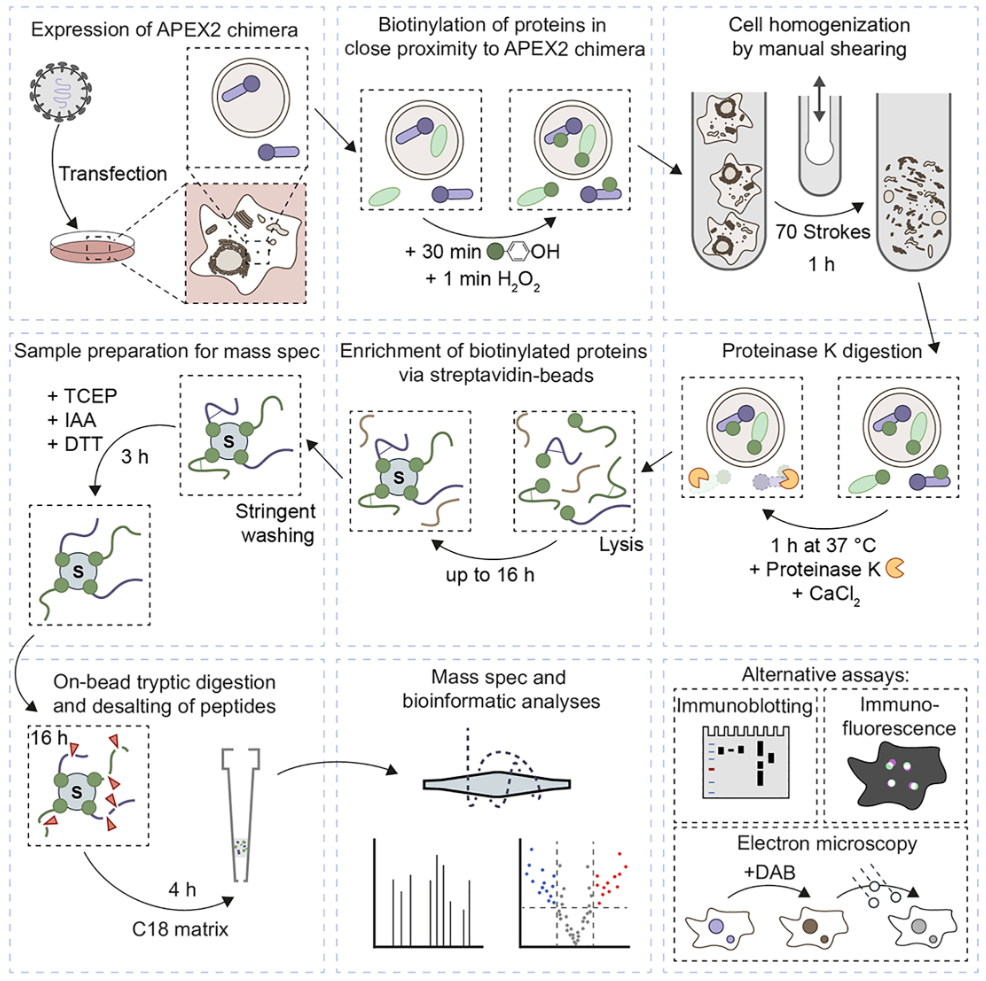Biotinylation Proteomics Analysis Service
- Protein–Protein Interaction Mapping: Identify and characterize interaction partners via proximity labeling and biotin-streptavidin affinity capture.
- Subcellular Proteome Profiling: Label proteins within specific cellular compartments (e.g., nucleus, mitochondria) for spatially resolved proteomics.
- Signal Pathway Investigation: Track dynamic changes in protein networks during cell signaling events.
- Protein Complex Characterization: Reveal composition and stoichiometry of endogenous or tagged protein assemblies.
- Target Validation in Drug Discovery: Use biotinylation to identify and confirm binding targets of candidate therapeutics.
- Live Cell Labeling: Enable in vivo or in situ labeling of proteins under native physiological conditions.
Biotin, also known as vitamin B7, is a small water-soluble molecule that plays a vital role in cellular metabolism, particularly as a cofactor in carboxylase-catalyzed reactions. Biotin's high-affinity interaction with streptavidin and avidin has made it an essential tool in modern biochemical and proteomic research. This strong and specific binding is widely exploited for labeling, enrichment, and detection applications across molecular biology. Protein biotinylation refers to the covalent attachment of biotin to target proteins, making them easily traceable, isolatable, and suitable for downstream experimental applications. Biotinylation can be achieved through two main strategies:
1. Chemical Biotinylation
Chemical biotinylation is a widely adopted approach for labeling proteins by covalently attaching biotin molecules to specific reactive groups of protein. This process typically employs biotin derivatives like avidin and streptavidin or biotin-PEO reagents. Chemical biotinylation is particularly useful when broad labeling or enrichment of proteins is desired in a controlled yet efficient manner.
2. Enzymatic Biotinylation
Enzymatic biotinylation offers high specificity and site-selectivity by using biotin ligases such as BirA to attach biotin to a defined peptide motif within the target protein. This technique is especially advantageous when precise biotin labeling is required. Its ability to modify proteins at predetermined sites ensures minimal off-target effects and greater experimental control.
Once biotinylated, proteins or peptides can be selectively captured through streptavidin-based systems, significantly improving the sensitivity and specificity of downstream analyses such as mass spectrometry or protein-protein interaction profiling. Biotinylation proteomics analysis leverages this principle to enable efficient identification, enrichment, and characterization of biotin-tagged proteins from complex biological samples. This approach is particularly valuable in mapping protein interaction networks, identifying post-translationally modified proteins, and profiling surface or proximity-labeled proteomes.
Service at MtoZ Biolabs
MtoZ Biolabs offers comprehensive Biotinylation Proteomics Analysis Services, tailored for both chemical and enzyme-mediated labeling strategies. Leveraging advanced mass spectrometry platforms and optimized enrichment workflows, our service enables accurate, high-throughput identification of biotin-labeled proteins, helping researchers uncover spatial, temporal, and functional protein networks with confidence.
Analysis Workflow
1. Sample Preparation
According to project requirements, proteins are extracted from submitted samples and prepared for analysis.
2. Enrichment
Biotinylated proteins are captured with streptavidin-coated magnetic beads.
3. Digestion
Enriched proteins are digested into peptides using trypsin or other proteases.
4. LC-MS/MS Analysis
Peptides are analyzed on high-resolution mass spectrometers.
5. Data Analysis
Identified proteins are annotated, and interaction or enrichment analysis is performed.
6. Report Delivery
Comprehensive report includes biotinylated protein lists and related data interpretations.

Figure 1. Workflow for Biotinylation Proteomics Analysis Service
Service Advantages
1. High Specificity and Affinity
Biotin-streptavidin interaction enables highly specific capture of biotinylated proteins, minimizing background interference.
2. Advanced Mass Spectrometry Platform
Powered by Orbitrap Fusion Lumos and nanoLC-MS/MS for high-resolution, high-throughput proteomic analysis.
3. One-Stop Service
From sample preparation to data interpretation, MtoZ Biolabs offers a seamless end-to-end service, reducing turnaround time and ensuring data consistency.
4. Customizable Experimental Design
Tailored experimental designs are based on sample type, experimental objectives, and downstream analysis needs.
Applications
Sample Submission Suggestions
We accept a wide range of sample types, including cells, tissues, protein lysates, and purified proteins. For best results, provide ≥100 µg of total protein or an equivalent amount of biological material. Please ensure samples are free of interfering substances (e.g., excess biotin or strong detergents) and stored at –80°C before shipping on dry ice.
*Note: Please contact us before shipping for any special requirements or pre-analysis consultation.
Deliverables
1. Comprehensive Experimental Details
2. Materials, Instruments, and Methods
3. Total Ion Chromatogram & Quality Control Assessment
4. Data Analysis, Preprocessing, and Estimation
5. Bioinformatics Analysis
6. Raw Data Files
Related Services
How to order?







